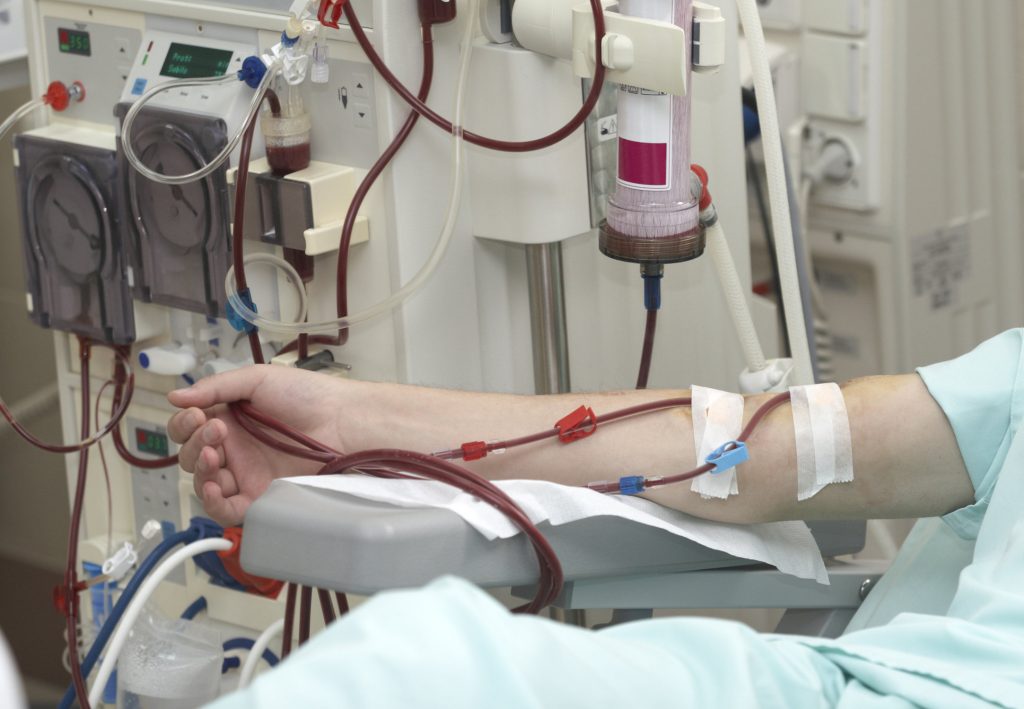Dialysis
What’s Dialysis?
It’s a treatment that takes over your kidney functions if those organs stop doing their job. There are two types of dialysis:
1.) Hemodialysis: Your blood is put through a filter outside your body, cleaned, and then returned to you. This is done either at a dialysis facility or at home.
2.) Peritoneal dialysis: Your blood is cleaned inside your body. A special fluid is put into your abdomen to absorb waste from the blood that passes through small vessels in your abdominal cavity. The fluid is then drained away. This type of dialysis is typically done at home.
What is hemodialysis?
While healthy kidneys have several functions in the body, the most well-known job is to produce urine. When kidney function goes below 10% to 15% kidneys are no longer able to filter the blood and make urine. This causes toxins to build up in the body along with excess fluid. Fortunately, we live in a time when there are treatments and medicines that can replace the functions of the kidneys and keep the body alive. One type of renal replacement therapy — meaning a treatment that replaces kidney function — is hemodialysis. Hemodialysis is a therapy that filters waste, removes extra fluid and balances electrolytes (sodium, potassium, bicarbonate, chloride, calcium, magnesium and phosphate).
How does hemodialysis work?
In hemodialysis, a dialysis machine and a special filter called an artificial kidney, or a dialyzer, are used to clean your blood. To get your blood into the dialyzer, the doctor needs to make an access, or entrance, into your blood vessels. This is done with minor surgery, usually to your arm.
What is Peritoneal dialysis?
Peritoneal dialysis (PD) has been a widely accepted method of treating end stage renal disease (ESRD) since the 1980s, and it is now the most common method of home dialysis. While many dialysis patients in the United States go to a dialysis center, PD offers more flexibility by allowing patients to dialyze at home, at work or on vacation.
To perform treatments, PD uses the thin membrane, called the peritoneum, which lines the abdomen. During treatments, a cleansing fluid called dialysate is put into the patient’s abdomen through a small, flexible tube called a PD catheter.
The dialysate pulls the waste and extra fluid from the patient’s blood into the peritoneal cavity and stays in the abdomen for a specified amount of time. Once the dialysate is drained, the wastes and fluids are also drained, and fresh dialysate is replaced to clean the blood. This filling and draining process is called an exchange because the dialysate that has been in the abdomen is being exchanged for new, fresh dialysate.
How does peritoneal dialysis work?
A soft plastic tube (catheter) is placed in your abdomen by surgery. A sterile cleansing fluid is put into your abdomen through this catheter. After the filtering process is finished, the fluid leaves your body through the catheter.
There are two kinds of peritoneal dialysis:
Continuous Ambulatory Peritoneal Dialysis (CAPD)
Automated Peritoneal Dialysis (APD)
The basic treatment is the same for each. However, the number of treatments and the way the treatments are done make each method different.
CAPD is “continuous,” machine-free and done while you go about your normal activities such as work or school. You do the treatment by placing about two quarts of cleansing fluid into your abdomen and later draining it. This is done by hooking up a plastic bag of cleansing fluid to the tube in your abdomen. Raising the plastic bag to shoulder level causes gravity to pull the fluid into your abdomen. When empty, the plastic bag is removed and thrown away.
When an exchange (putting in and taking out the fluid) is finished, the fluid (which now has wastes removed from your blood) is drained from your abdomen and thrown away. This process usually is done three, four or five times in a 24-hour period while you are awake during normal activities. Each exchange takes about 30 to 40 minutes. Some patients like to do their exchanges at mealtimes and at bedtime.
APD differs from CAPD in that a machine (cycler) delivers and then drains the cleansing fluid for you. The treatment usually is done at night while you sleep.
Kidney Transplant
What is a kidney transplant?
When you get a kidney transplant, a healthy kidney is placed inside your body to do the work your own kidneys can no longer do.
On the plus side, there are fewer limits on what you can eat and drink, but you should follow a heart-healthy diet. Your health and energy should improve. In fact, a successful kidney transplant may allow you to live the kind of life you were living before you got kidney disease. Studies show that people with kidney transplants live longer than those who remain on dialysis.
On the minus side, there are the risks of surgery. You will also need to take anti-rejection medicines for as long as your new kidney is working, which can have side effects. You will have a higher risk for infections and certain types of cancer.
Although most transplants are successful and last for many years, how long they last can vary from one person to the next. Many people will need more than one kidney transplant during a lifetime.


